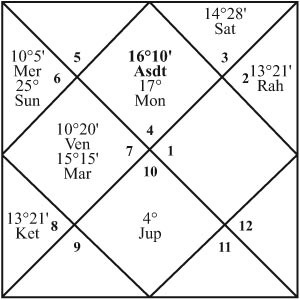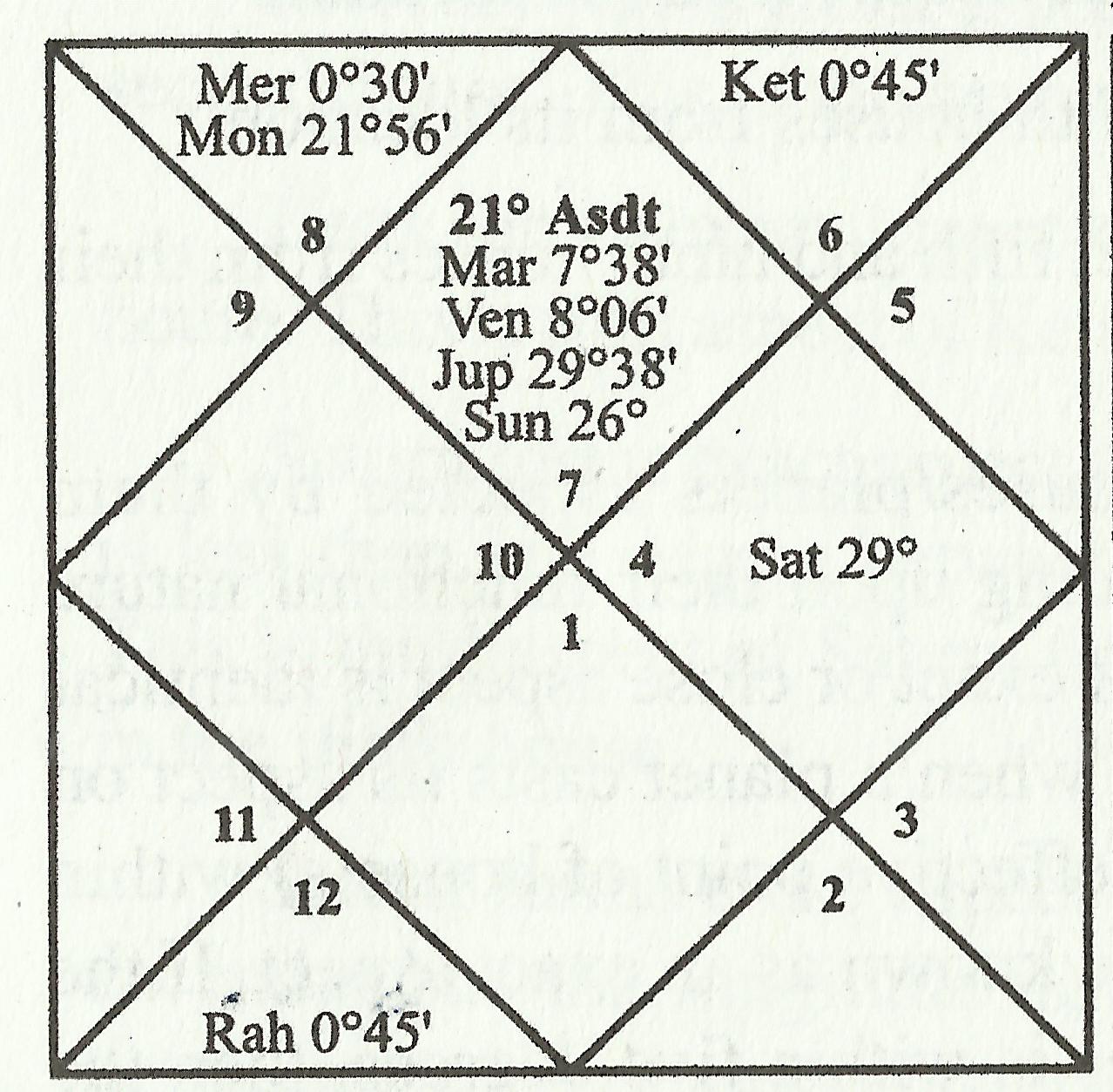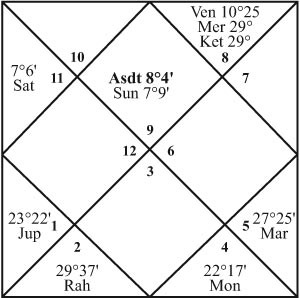| Home | Services | Free Weekly Horoscope | Mission of Life | Contact us |
LEARN ASTROLOGY - LESSON 3a
"GENERAL TERMINOLOGY CONTINUED"
Malefic Houses: The sixth, eighth and twelfth houses are called malefic houses. All other houses are benefic houses. The reasons for this rule are:
Besides the natal position of the planets, there is the most effective point (MEP) of each house known by the degree rising in the ascendant. The close impact of the planets in the case of houses is gauged through their closeness to the natal positions. Suppose an ascendant of 16 degrees rises. It means the most effective point of each house would be 16 degrees. In cases where the lord of a mooltrikona sign house is weak or it is a non-mooltrikona sign house, a functional malefic planet having a longitude between 11 to 21 degrees will afflict these houses either by placement or by aspect. In cases where the lord of a mooltrikona sign house is “otherwise” strong, then that house will only become afflicted under the single influence of a functional malefic planet having a longitude between 15 to 17 degrees, or under the multiple/special influence of functional malefic planet(s) having longitudes between 14 to 18 degrees. That “otherwise” strong lord will become weak for these reasons. The influence of any functional malefic planet over its own mooltrikona sign house will never be malefic, by way of close conjunction to the MEP.
Example chart No. 1 is given for clear understanding of the exact or close conjunctions.
In this chart the planets Venus and Mars are in exact conjunction in the ascendant as their longitude difference is less than one degree.
The planets Sun and Jupiter are in close conjunction as their longitude difference is within five degrees.
The Moon is in exact conjunction to the most effective point of the second house.
Though Jupiter and Mercury are in the first and second houses, respectively, they are in exact conjunction as their longitude difference is within one degree.
ASPECTS
The aspects are partial and full. In the Vedic system of Astrology, we are concerned with only full aspects. Each planet is believed to aspect fully the seventh house, reckoned/counted from the placement of the former.
In addition to this i.e. the seventh aspect, planets posited outside the orbit of the earth (Mars, Jupiter and Saturn) as well as Rahu and Ketu have additional special full aspects as under:
• Saturn aspects third and tenth houses from its location.
• Mars aspects fourth and eighth houses from its location.
• Jupiter, Rahu and Ketu aspect fifth and ninth houses from their location.
Planets influence other houses/planets aspected by them favorably or unfavorably, depending upon their functional nature in the horoscope. The principle of exact or close aspect is identical to exact or close conjunction i.e. when a planet casts its aspect on another planet(s) or on the most effective point of house(s) within an orb of one degree, the aspect is known as an exact aspect. If the difference in planetary longitudes is within five degrees, then the aspect is known as a close aspect.
EXAMPLE CHART NO. 2
This example is given for clear understanding of the exact or close aspects.
In this chart the planet Rahu closely aspects the Sun with fifth aspect as the longitude difference is less than five degrees.
The planets Mars and Jupiter mutually form close aspect as their aspect longitude difference is within five degrees.
Mercury forms an exact aspect to the most effective point of the second house. This is the seventh aspect of Mercury.
Ketu forms exact aspect to the Moon placed in the second house. This is fifth aspect of Ketu to the Moon from the tenth house.
Saturn forms exact aspect to Venus as the longitude difference is less than one degree between the longitude of the two planets. This is third aspect of Saturn from seventh house to Venus placed in the ninth house.
Saturn forms close aspect to the most effective point of the ascendant as the longitude difference is less than five degrees between the longitude of Saturn and the ascendant. This is seventh aspect of Saturn from the seventh house to ascendant.
WIDE CONJUNCTION OR ASPECTS
The conjunctions or aspects with more than five degrees of longitudinal difference are wide conjunctions or aspects. These do not have permanent impact in life except the short lived transit influences on the planets involved in wide conjunctions or aspects. The wide aspects give their results in the latter part of life, say around 60 years or after.
The aspect of a functional benefic planet will be effective corresponding to the strength of the planet(s)/house(s) involved. If the aspecting functional benefic planet is weak due to any reason including debilitation its effectiveness will be weak and limited, but its close aspect will always act as a helping force. The close aspect of a functional malefic planet, except on the most effective point of its mooltrikona house, will always act as a damaging force.
PLANETARY AVASTHAS (STATES) The planetary avasthas are the conditions
in which a planet is placed. The prominent
avasthas and the results produced are as under: a)
INFANCY: Whenever the longitude of a planet in a particular sign is less than 5 degrees, it is said to be in the state of infancy. Such a planet is incapable of fully promoting/protecting its general and particular significations. In example chart No. 1 Mercury is in infancy in the second house. In example chart No. 2 Mars is in infancy in the twelfth house. b)
OLD AGE: Whenever the longitude of a planet in a particular sign is more than 25 degrees, it is said to be in the state of old age. Such a planet is incapable of fully promoting/protecting its general and particular significations. In example chart No. 1 the planets Sun and Jupiter are in old age in the ascendant. In example chart No. 1 Saturn is also in old age in the tenth house. c)
OWN SIGN: A planet in its own sign is treated as strong and is capable of generating the expected results, provided it is otherwise strong. d)
MOOLTRIKONA SIGNS : A planet in its mooltrikona (MT) sign is treated as very powerful, provided it is otherwise strong. e)
EXALTATION: The planets are in the state of exaltation in particular signs and give good results by promoting/protecting their general and particular significations, provided they are otherwise strong. The exaltation signs of various planets
are as under:
the sixth house rules diseases, debts and disputes;
the eighth house rules obstructions, fatal accidents and death; and
the twelfth houses rules expenses, losses and imprisonment.
The significations ruled by the planets suffer:
(a) When any planet is placed in any of the malefic houses. This is not applicable when a mooltrikona sign lord of a particular malefic house is placed in its own mooltrikona sign house. For example, if the sign Libra falls in the sixth house and Venus is placed in the sixth house, in which resides its own mooltrikona sign, the significations of the Venus will not suffer. The significations of Venus will prosper if Venus is not in infancy, old age or afflicted, and is strong.
(b) ) When any of the planets/houses are under the close influence through aspect/conjunction of the lords of the malefic houses.
General and Particular Significations of Planets:
The general significations of a planet indicate the aspects ruled by that planet. For example, the Sun rules father, status of the person, job, heart, digestive system, etc. irrespective of the lordship of the Sun in a particular birth chart.
The particular significations of a planet indicate the significations of its mooltrikona sign house in the natal chart. If the sign Leo rises in the third house then the Sun will rule the third house. The significations of the third house will be known as particular significations of the Sun.
The results of the significations of a weak planet fructify with delay and suffer whenever that weak planet is afflicted due to close aspect or conjunction with any functional malefic planet. The natal affliction causes damages in the entire sub-periods of the weak planet and the afflicting planets. The transit affliction causes short term damages during the effective transit influence.
Functional Nature of Planets:
The functional nature of planets is the key analytical factor in the horoscope analysis. Besides Rahu and Ketu, the planets, whose mooltrikona signs are in malefic houses (sixth, eighth and twelfth) with reference to the ascendant, act as functional malefic planets in a birth chart. For this purpose, under the Systems’ Approach the sign of Cancer is considered as the mooltrikona sign of the Moon.
THE MOST EFFECTIVE POINT OF A HOUSE

For more clarity, let us see this concept through the following example chart. Some of the points previously discussed are further explained in this example, including conjunctions, aspects, weak planets and strong planets.
In the above chart the rising degree of the ascendant is 16°10'. This 16°10' becomes the most effective point (MEP) of each house. Now we will see the application of close aspects, close conjunctions, exact conjunctions, exact aspects, single afflictions, special afflictions and multiple afflictions in the above chart.
Based on the placement of the Sun in the third house, the orb of affliction for the second house by a single functional malefic planet appears to be one degree. There is no functional malefic planet which afflicts the second house within an orb of one degree. However, the second house can be afflicted by a special affliction or multiple afflictions within an orb of two degrees. We find in this example chart that the second house MEP is indeed under a special affliction of the most malefic planet, Saturn, from the twelfth house within an orb of two degrees. This situation not only causes affliction to the second house, but also makes the otherwise strong Sun weak, due to afflictions to its mooltrikona sign house. The second house thus becomes weak and vulnerable to natal or transit afflictions within an orb of five degrees on either side of the MEP.
The Moon is strongly placed in the ascendant and it forms an exact conjunction with the MEP of the ascendant and an exact aspect to the MEP of the seventh house. Therefore the Moon and MEP of the ascendant becomes vulnerable to transit afflictions within an orb of one degree.
Mercury is strongly placed in its mooltrikona sign in the third house. There is no natal affliction to the third house or natal Mercury. Natal Mercury and the MEP of the third house become vulnerable to transit afflictions within an orb of one degree.
Jupiter is weak in the chart due to: (i) it is in its sign of debilitation; (ii) its mooltrikona sign house is under a special affliction of the most malefic planet, Saturn, from the twelfth house; and (iii) it is in the state of infancy. Therefore, both Jupiter and the sixth house are vulnerable to natal and transit afflictions within an orb of five degrees.
The functional benefic planet Mars is strongly placed in the fourth house and it closely and beneficially influences the MEP of the houses occupied and aspected. Therefore, both Mars and the tenth house are vulnerable to natal or transit afflictions within an orb of one degree.
The functional benefic planet Venus is strongly placed in its own mooltrikona sign in the fourth house; this placement of Venus beneficially helps the fourth house. Therefore, both Venus and the fourth house are vulnerable to natal or transit afflictions within an orb of one degree.
The most malefic planet Saturn is weak as it is badly placed. It severely afflicts the houses occupied and aspected. Both Saturn and the eighth house are vulnerable to natal or transit afflictions within an orb of five degrees.
Rahu and Ketu form close afflictions to the eleventh, fifth, seventh and ninth houses as the orb of afflictions for the non-mooltrikona sign houses is five degrees on either side of the MEP.
We trust that this example will help the reader in understanding the concepts of: the most effective point of the house(s); and special afflictions and multiple afflictions through close or exact conjunctions/aspects. This understanding will go a long way in helping with your comprehension of the case studies included here and in our other books.
Conjunction is the apparent coincidence or proximity of two or more celestial objects as viewed from the earth. The conjunction can be exact or close. If the difference in longitudes happens to be less than one degree, the resulting conjunction is known as an exact conjunction. If the difference in longitudes is within five degrees, the same is known as a close conjunction.
EXAMPLE CHART NO.1


In example chart No. 1 Venus is in its own house. In example chart No. 2 the Moon is in its own house.
Under the Systems' Approach, the mooltrikona signs of various planets are as under:
PLANET MOOLTRIKONA SIGN
SUN:L EO
MOON: CANCER
MARS: ARIES
MERCURY: VIRGO
JUPITER: SAGITTARIUS
VENUS: LIBRA
SATURN: AQUARIUS
In example chart No. 1 Venus is in its own mooltrikona sign house. In example chart No. 2 the Moon is in its own mooltrikona sign house.
PLANET
EXALTATION SIGN
SUN:
ARIES
MOON:
TAURUS
MARS:
CAPRICORN
MERCURY:
VIRGO
JUPITER:
CANCER
VENUS:
PISCES
SATURN:
LIBRA
RAHU:
TAURUS
KETU:
SCORPIO

